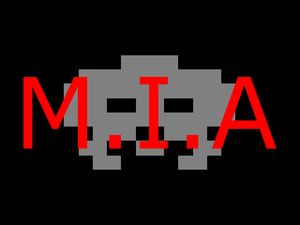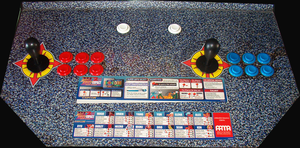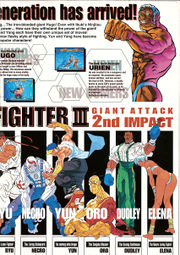Lost In Translation/Street Fighter III - 2nd Impact : Giant Attack
| Street Fighter III 2nd Impact : Giant Attack | |
|---|---|
| Manufacturer | Capcom |
| Released | 1997 |
| Control Method |
8-way Joystick 6 Button(s) |
| Main CPU | SH-2 (@ 25.000 MHz) |
| Sound CPU | Stereo Custom (@ 14.318 MHz) |
| Video Details |
Raster (Horizontal) 384 x 224 pixels 60.00 Hz 65,536 Palette colours |
| Screens | 1 |
| ROM Info | 1 ROM plus Laserdisc, Hard Disk or CD-ROM 524,288 bytes (512.00 KiB) |
| MAME ID | sfiii2 |
About The Game
Street Fighter III - 2nd Impact : Giant Attack is a one-on-one fighting arcade video game.
The sequel to "Street Fighter III - The New Generation". Joining the existing Street Fighter III cast are Hugo, Urien and recurring character Akuma (Gouki in the Japanese version). Other improvements include a speed increase, new moves and several damage-related tweaks.
Additional Technical Information
Players : 2
Control : 8-way joystick
Buttons : 6
= > [1] LP, [2] MP, [3] HP
= > [4] LK, [5] MK, [6] HK
Trivia
The 'Giant Attack' subtitle refers to the 2 huge characters that are added to the Street Fighter III series with this game : Hugo and Urien.
Released in September 1997.
This is the only CPS3 game to feature a widescreen mode.
The character Hugo is based on the late WWF Hall of Famer André the Giant. He also made an appearance in "Final Fight" as a non-boss enemy.
The character Urien is identical in figure and fighting style to the boss character, Gill, except that Urien has much less hair, and his skin is the same color on both sides.
Gill, the boss character, has added a new Super Art to his arsenal, 'Meteor Strike', which is the only one listed as available in the Vs. screen. However, he DOES still have access to his 'Resurrection' Super Art.
Tips and tricks
Enable Widescreen Mode
Do the following:
- Go to Test Menu->Configuration->Game.
- Change Screen Mode to Wide and save your settings.
Hidden Character
To enable Gouki/Akuma as a playable character go to Test Menu->Configuration->Game. Then highlight in this order :
- 'Time Count Speed' and press START x3
- 'Event' and press MK x2
- 'Screen Mode' and press HK x3
- 'Bonus Game' and press START x1
- 'Damage Level' and press LK x4
If you hear Gouki's/Akuma's voice, the input was correct.
Second Method To Play As Gouki/Akuma
At the Character Select Screen, highlight RYU and press DOWN, DOWN, UP -> move to Ken and press UP(x2), DOWN -> move to Ryu and press UP -> move to Ken and press DOWN -> move to Sean and press DOWN(x2), UP, DOWN, UP(x3). Gouki's/Akuma's portrait should appear above Sean.
Series
- Street Fighter (1987)
- Street Fighter II - The World Warrior (1991)
- Street Fighter II' - Champion Edition (1992)
- Street Fighter II' - Hyper Fighting (1992)
- Super Street Fighter II - The New Challengers (1993)
- Super Street Fighter II Turbo (1994)
- Street Fighter Alpha - Warriors' Dreams (1995)
- Street Fighter Alpha 2 (1996)
- Street Fighter III - New Generation (1997)
- Street Fighter Alpha 3 (1998)
- Street Fighter III - 2nd Impact : Giant Attack (1998)
- Street Fighter III - 3rd Strike : Fight For The Future (1999)
- Hyper Street Fighter II - The Anniversary Edition (2003)
- Street Fighter IV (2008)
Staff
- Character Design
- Who
- D-Kurita
- Chimorin Shogun
- Shibaki
- Chun
- Jun Ikawa
- Seiji Yano
- Yuki Ishikawa
- Shinnosuke N.
- Scroll Design
- Hiroshi Sugiyama
- Yoko Fukumoto
- Hiroyuki Imahori
- Ojiji
- Naobei
- Akemi Kohama
- Tama
- Yamamoto Koji
- Kouichi Takeda
- Original Art Work
- Akiman
- Kinu Nishimura
- NK
- Title Logo Design
- Shoei
- Instruction Design
- Sakomizu
- Programming
- Kazuhito Nakai
- Nobuya Yoshizumi (LT1)
- Yuko Kawamura (TATE)
- Hiroshi Nakagawa
- Yosinobu Inada (INE)
- Masahito Oh!Ya!
- Akihiro Yokoyama
- Sound Effect Design
- Satoshi Ise
- Hiroaki "X68k" Kondo
- Music Compose
- Hideki Okugawa
- Yuki Iwai
- Music Arrangement
- Hideki Okugawa
- Planning
- Seto Yasuhiro
- Neo_G H.Ishizawa
- Numach
Voice Actor
- Ryu & Yun Lee
- Wataru Takagi
- Ken Masters & Yang Lee
- Koji Tobe
- Sean Matsuda
- Isshin Chiba
- Ibuki/Effie
- Yuri Amano
- Elena
- Kahoru Fujino
- Oro
- Kan Tokumaru
- Urien
- Yuji Ueda
- Akuma
- Tomomichi Nishimura
- Alex & Necro
- Michael X. Sommers
- Dudley & Gill
- Bruce Robertson
- Hugo
- Len Carlson
- Message Translator
- Erik Suzuki
- Dan Okada
- Chris Tang
- Yumiko Nishi
- Karla Oshiro de Freitas
- Producer
- Tomoshi Sadamoto
- General Producer
- Noritaka Funamizu
- Yoshiki Okamoto
- Special Thanks
- Tsuyohi
- Mayano
- Tomo
- Blbon
- Takafumi Sagata
- M.Aoki
- N. Akei
- H. Nakamura
- H. Ojima
- Yoji Mikami (X68k)
- Takuya Shiraiwa
- Rita Rokos
- Ryoji
- Hard Yas (-Follow-)
- CS Bug Checkers
- Kunishige Matsubara
- Manabu Matsumoto
- Tomoyuki Yokota
- Tetsuya Haze
- Katsusuke Miura
- Masahiro Kajitani
- Takashi Hashimoto
- Yoshihiko Kurata
- Yoshihiro Tomita
- Daisuke Sasaki
- Akinori Murata
- Skill Smith - Test Play
- TTK-K.S
- Hiroshi.Sugimoto-Bug
- Gon
- Kohsuke-Arai (TKO)
Cabinet and Artwork
Ports
- Consoles
- Sega Dreamcast (1999, "Street Fighter III W Impact") (Japan only)
- Sega Dreamcast (2000, "Street Fighter III Double Impact")









